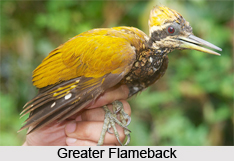 Greater Flameback is an Indian bird that bears a scientific name of "Chrysocolaptes guttacristatus" and falls in the family of flameback category.
Greater Flameback is an Indian bird that bears a scientific name of "Chrysocolaptes guttacristatus" and falls in the family of flameback category.
Category of Greater Flameback
Greater Flameback is a large golden-backed woodpecker. This bird is also known as Malherbe`s golden-backed woodpecker. It falls in the family of woodpecker species.
Concentration of Greater Flameback
Greater Flameback occurs widely in the Indian states, eastwards to southern China, the Malay Peninsula, Sumatra, western and central Java and northeast Borneo.
 Structure of Greater Flameback
Structure of Greater Flameback
Greater Flameback is a large woodpecker, at 33 cm in length. It is of typical woodpecker shape, has an erect crest and a long neck. Coloration is highly variable between subspecies; it always has unmarked golden-yellow to dark brown back and wings. The rump is red and the tail is black. The underparts are white with dark markings (chevrons, stripes, or bands), or light brown. The head is whitish with a black pattern, or it is yellow, brown or red. The straight pointed bill is long (longer than the head) and like the legs and four-toed zygodactyl feet (two toes pointing forward, two backward) - lead-grey. The eyes` irides are whitish to yellow.
Adult Greater Flameback
The adult male Greater Flameback always has a red crown. Females have a crown colour varying between subspecies, such as black spotted with white, yellow, or brown with lighter dots. The young birds are like the female, but duller, with brown irides.
Eggs of Greater Flameback
Greater Flameback uses its bill to dig out food from trees and its zygodactyl feet and stiff tail to provide support against tree trunks. The long tongue can be darted forward to extract wood-boring arthropod prey; while mainly feeding on small invertebrates; greater flamebacks will also drink nectar. They nest in tree holes, laying three or four white eggs.



















